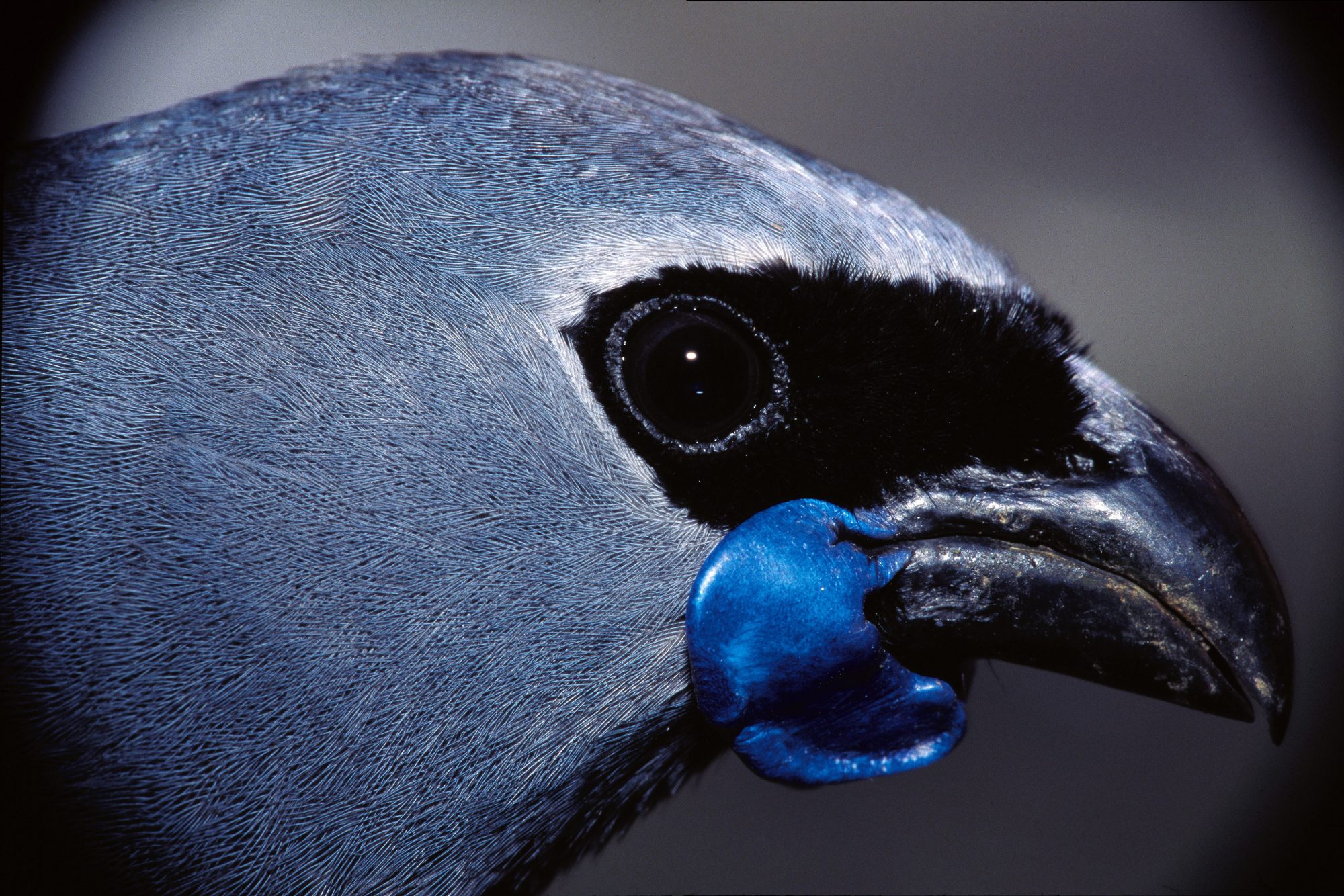
Kokako
Angel-tongued and devil-faced—kokako is one of our rarer and most striking birds. Two species once flourished: an orange wattled South Islander, declared extinct in 2004, and the blue wattled North Islander. With resurging numbers (now exceeding 600 breeding pairs), conservationists are optimistic that their haunting song will again flood through the forests of the North Island.
The first chimes rang from afar. They were followed by a resonant harmony of high-pitched twangs, warbles and whines that raised the hackles on our necks. A pair was calling—due west across a deep gut—from the vicinity of Pa Ridge. There was only one thing for it. We hoisted our tape deck aloft on outstretched arm, “play” button depressed, and launched our own song skywards into the cool southerly. This failed to elicit a response, however, so we lowered the recorder and rubbed our hands warm again. We kept our ears turned in the direction of Pa Ridge, but except for the swishing of some swaying leafage overhead, silence prevailed.
Then an observant eye picked out a sharp speck hurtling from a treetop on the far side of the gut. This was tailed by a second: two dark arrows whizzing towards us across the intervening 100 m of airspace. These arrows rapidly metamorphosed into crow-sized birds crashing into the head of a tawa just down from where we stood. The kokako—for that’s what they were—didn’t stop there, but bounded, squirrel-like, up to the topmost branches, where they recommenced their melodious duet. We fumbled for our binoculars.
My daughter Hazel had had fleeting glimpses of wild kokako before, but nothing like this. She was helping out with the latest Kaharoa Kokako Trust census of territorial pairs in the Bay of Plenty forest of the same name. The morning light was exceptionally good, and Hazel’s vantage point, higher up the spur than mine, placed the two wattlebirds a little above head-height. She’d heard me waffle non-stop about these birds since 1989, the year both she and a ground-breaking kokako research-by-management (RbM) programme, in which Kaharoa Forest was to play an integral part, had hatched. Now, eyepieces wiped free of grit and focus adjusted, she was finally ingesting some of that elusive avian magic first-hand.

The higher kokako—the male—swayed from a branch, his glossy-black “robber mask” directed skywards as he threw his spooky calls out over the forest. From head to tail, apart from that heavy kohl and some delicate brown shading to wings, tail, rump and abdomen, his plumage was an elegant blue-grey. Curling under his throat from the base of his black bill were two daubs of vivid blue, the wattles—loose folds of skin—from which came the bird’s original Pakeha name: blue-wattled crow. His body was held aloft by legs that resembled a pair of black drinking straws, yet were more powerful than that description might suggest.
He fanned his tail feathers, then stretched out his wings, sweeping them up and back, repeatedly—ritualistically flapping them—while singing an onomatopoeic “koe-kah-koe”. Not only is such wing-clapping a visual display, it also, like an audio-locator beacon, helps the gregarious birds find each other in their densely forested habitat.
The lower kokako—the female was smaller. Her colouration was identical to the male’s apart from more extensive brown tingeing, suggesting a younger bird. Her wattles were smaller, too. She rubbed her bill against a stout limb, then tilted her face upward, parrot-like. Barely two metres from her mate, she began plucking at toatoa leaves, pausing every so often to provide synchronised echo notes or otherwise complement his outpouring, hunching her back while her wattles vibrated with the effort of converting two lungfuls of antipodean air into one of the most exquisite melodies to be heard anywhere on Earth. Such birdsong—to a human ear—is a spiritual evocation: mournful, comforting, eerie, and more soulful than the purest New Orleans Dixieland.
We followed the pair for over 50 minutes, recording behavioural idiosyncrasies, noting diet and plotting the dimensions of their territory. Once we’d obtained the requisite data, we broke off and rejoined census co-ordinator Carmel Richardson. Carmel is a Hamurana local who has been involved with the kokako of Kaharoa since 1991, making her one of the country’s foremost field experts on this endemic species. She explained how kokako territories ranged in size from four to 12 ha, and that a single bird, not necessarily a pair, could hold a territory.
The presence of kokako indicates a relatively intact and healthy forest ecosystem. The bird has an omnivore’s broad palate: tawari nectar, puka leaves, pigeonwood drupes, tiny snails, chilli peppers (stolen from the ranger’s vege garden on Little Barrier/Hauturu Island), thumb-sized grubs, 18 cm-long stick insects—all these and more feature in its diet. It is an important disperser of large-seeded forest plants.
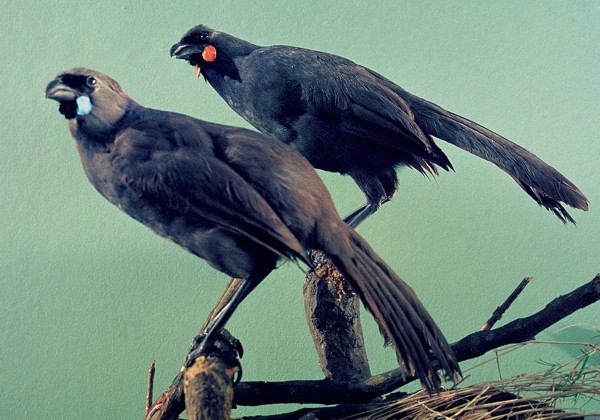
The southerly was beginning to bite so we got moving again, intent on surveying the last ridge system, Pa Ridge itself.
The approaches to Pa Ridge are clothed with tawa and rimu forest, replete with perching plants, ferns, rare orchids, vines, climbers, palms and tree ferns, including giant mamaku. There was therefore no shortage of things to look at on the way. Pa Ridge is itself is a prominent spur extending northwards from one of Kaharoa’s two ignimbrite plateaux, both riven by canyons and gorges. Over the past 18 years, introduced mammalian pests in the area have been drastically reduced in number by trapping and poisoning, which has benefited not just kokako but the entire Kaharoa ecosystem.
The guardian of the pa pulled us up: a grizzled ruru, or morepork, perched on a horizontal branch lying directly over the game trail we were following. We stopped and gawked, and paid due respect. The wise one must have known of our quest—sanctioned by tangata whenua—not only to restore the mana of Tane, god of the forest, but also to enhance the mauri, or life force, of his realm, Te Ngaere itself. With silent wing-beats, he led the way, and we followed on foot.
Five minutes on, we struck tall second-growth hardwood forest, comprising mainly kamahi, tawa and hinau trees but interspersed with young podocarps such as toatoa and tanekaha. The outlying earthworks of the pa soon followed—a tremendously deep scarp, the first of two—barring the way. We sidled round but hurried through the length of the site as we wanted to prospect for kokako further down, on a razorback spur that dropped steeply into the confluence of two rivers. A handful of whio, or blue duck, were known still to patrol these rumbling white waters. The spur fell away so steeply that the occupying Maori must surely have used vine ladders to access the water and the foot trail that followed the streambed out to the coast.
The wind was getting up and would soon mask the calls of distant kokako. We arrived at our spot, groping inside a pack for the tape-recorder, and soon more canned song was being projected skywards. Eventually another pair of the wattlebirds came into sight, although they remained firmly anchored to the far bank: two specks swaying and singing in their respective rewarewa trees. Our binoculars enlarged their silhouettes, but squinting into the glare they could easily have been mistaken for blackbirds.
From among the stunted growth on the razorback, we watched and listened. After a while, with no adieu, one bird vanished, and not long afterwards the other dropped off its perch and sprang from branch to branch until it, too, disappeared behind a wall of greenery. Some of us kept our binoculars trained and saw this second bird re-emerge, wings outstretched, and “toe it” along draped vines and level branches.
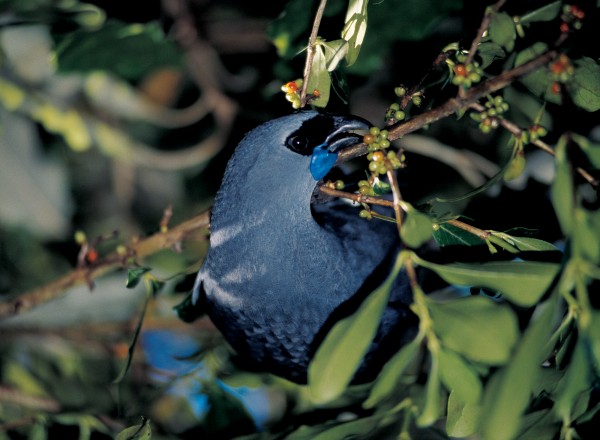
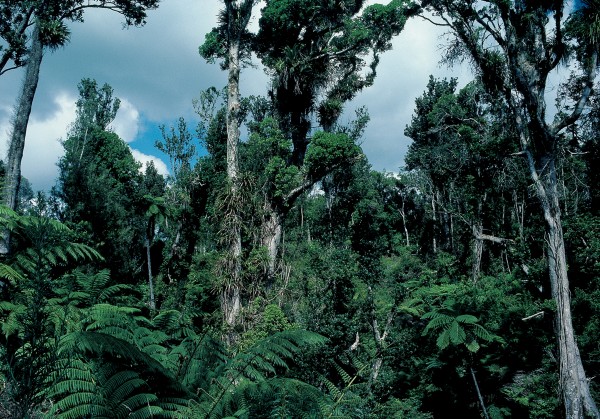
Kokako are essentially weak fliers. They move through the forest canopy by alternately gliding, during which they lose altitude, and hopping vigorously to regain it, utilising forward momentum for both long and high jumps. As we watched, this bird, its long legs working like springs and its stubby wings generating extra lift, made an upward traverse across several vertiginous gaps from a kamahi to a taller tanekaha. Once it had zigzagged to the tanekaha’s summit, it stopped and craned into the wind, before launching itself into space and out of sight, this time for good.
We backtracked to the pa, which was also suspected to be the haunt of a kokako or two, using root handholds to pull ourselves up onto the first of two terraces. From there it was a short clamber to the second terrace and then onto the top platform, where we dropped our packs. From all sides, glorious native forest pressed inwards. By taking time and care you could see depressions where whare had once stood, while dug into the western and southern flanks of the platform were eight or nine kumara storage pits, most of which had caved in and sprouted sizeable tree ferns. There was a handful of totara palisades as well—long brown slabs, cracked with age—last survivors of the stockade and no less weathered than those tattooed Arawa faces so finely captured on canvas in the early 1900s by Charles Goldie. Although we searched, no kokako could we find.
The old-time Whakatohea bird-hunters of the Bay of Plenty were well-acquainted with the swift and ghostly kokako. In fact, the hapu Ngati Ira have a legend: Ta Kokako a Kotikoti—The Flocking Crows of Kotikoti. This tells of a memorable skirmish when a wickedly fast Ngati Ira taua overhauled some Tuhoe enemies, themselves no slouches in the bush. The Ngati Ira warriors surrounded the Tuhoe, taking captive Te Whatupe, whom they later killed and ate, and were subsequently dubbed Te Kokako a Kotikoti on account of the speed and agility they had displayed in this encounter. Kotikoti was a noted tipuna who had been an expert at snaring forest birds. On one foray he had captured several kokako, which he had carried back to his whare in a woven basket and left with his wife. She was fumbling with the opening when a hangi stone slumped out of place in the umu, and as she twisted round to realign it, every last one of the kokako shot the gap, catching her off balance, and vanished from sight.
There were once two species of kokako—the blue-wattled, North Island Callaeas wilsoni (which we had been observing), and the orange-wattled, South Island Callaeas cinerea, which the Department of Conservation (DOC) formally declared extinct in 2004. Both belong to the family Callaeidae, which also includes the two species of tieke (saddleback) and the now extinct huia. Sub-fossil evidence shows the southern “crow” was once found throughout the South Island and also inhabited Stewart Island and a number of islands in the Marlborough Sounds. There are countless records of New Zealanders encountering it in the 19th and early 20th centuries: farmers on Banks Peninsula; naturalists roving Stewart Island; Fiordland explorers; prospecting Coasters; trophy-deer stalkers; pioneering alpinists. More often than not these tame birds were noted because they ended up in the camp oven after being whacked with a stick or dispatched with a charge of birdshot. As was the case with many of New Zealand’s endemic birds, the South Island kokako displayed a fatal naivety towards introduced predators, including man.
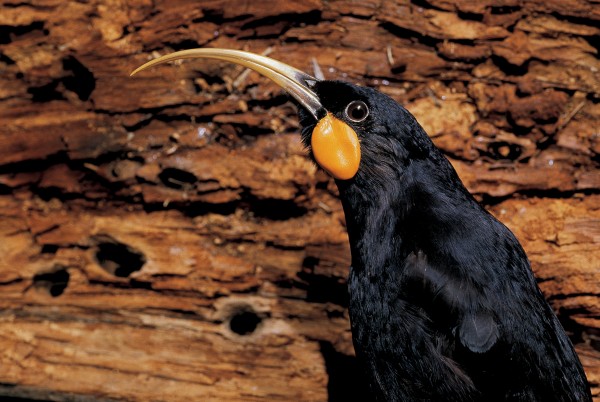
The Westland explorer Charlie Douglas had this to say about his region’s crow:
As I write they are about the camp in dozens… The bill is strong and a powerful cutter down of potatoe, stocks, peas etc. At the side of the jaws are two bright [orange-] red wattles, hanging down like those of a domestic fowl, only much smaller. In some birds these wattles are blue. A long thin tail and long ungainly black legs that appear to be weak in the knees when running along the ground. The feet and to the knee make an impression on the sand, the claws forming the usual government brand, the broad arrow, but as the leg from claws to knee also press on the sand, it leaves a mark like a large bird with a very long spur… They are a harmless playfull sort of bird, easy to tame and can be caught either with a snare, or by applying salt to their tails [via fowling-piece]… If they get into a garden, where young peas, cabbages and potatoes are shooting up, the crow goes in for a little fun, or mischief some people would call it—he doesn’t eat anything apparently, but cuts the young plants close to the ground, and lays them carefully down… When singing, they cast their eyes upwards like a street musician expecting coppers from a fourth storey window, and pour forth three or four notes, softer and sweeter than an Aeolian harp or a well toned clarionet…
At the dawn of the 21st century I (Marsh) sought out these sweet southern notes for myself. The lowland forests of Westland—both selectively logged and virgin stands—still clothe immense swathes of terrain. At one time they abounded with kokako. While carrying out kiwi-related and more general wildlife duties there, from early 2001 to mid-2004, we worked—mainly in excellent weather conditions—some of the catchments most likely still to harbour a remnant crow or two: north of the Cascade River; Hindley Creek; the Cook River; the Wanganui and Adams Rivers; and the north and south Okarito forests.
The 11,000 ha South Okarito Forest provides arguably the best habitat for kokako: dense stands of rimu, Hall’s totara and other podocarps, with Westland quintinia, kamahi, mountain toatoa and great southern rata. In fact, the renowned Franz Josef alpine guide Alex Graham once reminisced about the crows he commonly saw as a boy, circa 1900, while walking to school each morning from his family home beside Three Mile Lagoon.
Over the course of a hundred or so fly-camp mornings and many more diurnal kiwi missions, we were privy to numerous stupendous ecological phenomena in the Okarito block, the most unforgettable being the periodic combined ship rat irruptions/stoat plagues and the damage these caused to flora and other fauna. During our three-and-a-half-year stint on the Coast, there were two catastrophic events of this kind in two consecutive breeding seasons, the first fuelled by a rimu mast, the second by a kahikatea mast.

Two seasons of pestilential carnage is one matter, but a century’s worth is quite another; hence the current widespread absence of (to name but a few) piopio (New Zealand thrush), mohua (yellowhead), bush wren, weka, various petrels, red-crowned kakariki, kakapo, pekapeka (long-and short-tailed bats), tieke, whio, pateke (brown teal) and kaka. To this day hundreds of rimu, totara, rata and other trees in the South Okarito Forest sport trunks scored by once multitudinous kaka. Of the orange-wattled crow, despite our ears being cocked 24/7, not so much as a callaeidic twitter did we hear.
In the North Island, the multi-tiered complexity of dense podocarp and podocarp-hardwood forest—notably the rimu-tawa canopy matrix and its associated softwoods and hardwoods—has somehow allowed the blue-wattled kokako to prevail longer than its southern relative. Nonetheless, by the 1980s it was no longer found in the lower North Island. From that time, tawa the tree became synonymous with kokako the bird. However, the lowland tawa forests have been irrevocably modified over the past millennium by irruptions of kiore (Pacific rats, long underrated as introduced arboreal and terrestrial predators) and human-induced fires, and over the last 150 years have been heavily logged for timber and cleared to make way for roads, pasture and pine plantations.
The ecosystems on which the North Island kokako depends have also had to contend with a relatively recent tidal wave of introduced pests: brush-tail possums, Norway and ship rats, mustelids, feral cats, goats, pigs and deer numbering in their many millions. The bird hit a low in the 1980s, numbering only some 350 pairs scattered through Puketi and Mataraua Forests in Northland, the Hunua Ranges south of Auckland, Great Barrier Island, Coromandel Peninsula and various Bay of Plenty, King Country and Pureora (east of Lake Taupo) forests. Te Urewera was, and remains, home to by far the densest concentration. Many of the smaller outlying populations were doomed, generally consisting as they did of a handful of ageing males.
The turning point for the species came about with the creation of a kokako RbM programme, conceived during a workshop of interested parties held in Rotorua in 1988. Collaboration between DOC and the Forest Research Institute (FRI), Rotorua, ensured the programme’s implementation. From the start, FRI ecologist John Innes was a key player, investigating predator–prey relationships, but the progamme also tapped into Forest & Bird contract scientist Rod Hay’s hard-won findings of the late 1970s and early 1980s. Rod at this time was arguably the country’s leading authority on kokako. Others to contribute later were ecologists Hugh Best, Ralph Powlesland and Peter Bellingham.
The programme—eight years of rigorous experimentation and monitoring—was launched in 1989. Its aims were, first, to identify the cause of kokako decline and, second, to design a cost-effective protection regimen that would enhance the birds’ overall breeding success wherever it was applied (thereby offering some hope to otherwise doomed mainland populations). This work was carried out simultaneously in three separate kokako blocks: Kaharoa and Rotoehu Forests (both in the Bay of Plenty) and Mapara Wildlife Reserve (south-east of Te Kuiti).
The 840 ha Kaharoa Forest (including the Onaia Ecological Area) was trapped and treated with the poisons 1080, pindone and cyanide for three years to reduce the numbers of introduced predators, notably possums and ship rats.

In the 3150 ha Rotoehu Forest there was initially no pest control, the kokako population being monitored to see what happened to it when left to fend for itself. Remote time-lapse video cameras and night-vision scopes provided indisputable evidence that hawks (Australasian harriers), possums and ship rats were significant predators of kokako, the last of these proving to be the single greatest threat. For the final three years of the study, possums and ship rats were trapped and poisoned with cyanide, 1080 and brodifacoum.
In the 1400 ha Mapara Wildlife Reserve predators were rigorously controlled for the whole eight-year period by shooting, trapping and poisoning (with 1080 and brodifacoum). Stoats in particular were implicated in nest failures.
In all three blocks, breeding output from one season to the next, in terms of fledged juveniles per nest, was recorded, allowing cross comparisons to be made.
The 1989–97 RbM kokako programme was unique in that it was a complex, cooperative and highly successful effort: DOC and Landcare Research managers organised the large-scale pest-control campaigns; a mixture of hunters, trappers, rangers, volunteers and kokako-trackers carried out the work on the ground; and DOC and Landcare Research scientists analysed the data and drove the whole project. Underpinning the study was the national Kokako Recovery Group (KRG), working largely by consensus to provide sound advice as well as liaising with the general public and various internal and external agencies.
The programme was successful in its first aim: it was found that predation at the nest—rather than competition from introduced browsers, as had been posited—was the main cause of declining kokako numbers. To protect those remnant populations still holding on, the major predators—possums and ship rats—would have to be reduced to, and kept at, very low numbers. If this were done, the programme should have succeeded in its second aim, allowing managed kokako populations to prevail indefinitely on the mainland.
What is now Mapara Wildlife Reserve was once the archetypal “dead wood” of the King Country, crawling with mobs of wild goats. Then successive posses of DOC goat-hunters cleaned the place up, shooting some 8500 animals over a period of 20 years. Those early cordite-heavy forays allowed the under-storey vegetation to flourish anew, and today the bush is like a luxuriant warm-temperate jungle.

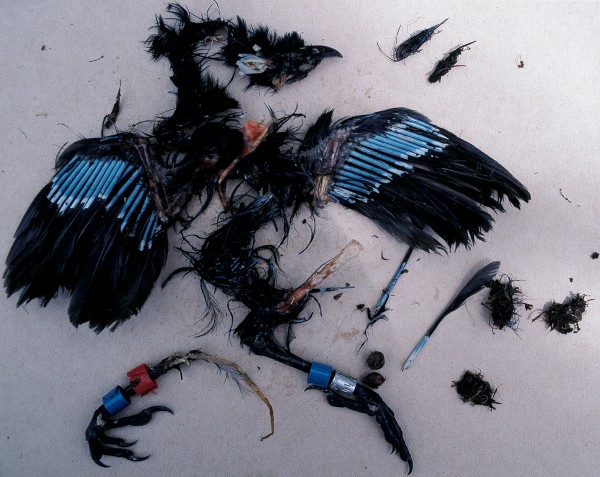
In addition to the culling, trapping and poisoning of mammals injurious to kokako, Mapara has seen the capture, in mist nets, of the birds themselves as numbers have risen. Captives are colour-banded or fitted with miniature transmitters, then released, so they can be identified and tracked for the purposes of gathering data. Skilled field workers are needed for this work, and over the years many accomplished researchers and wildlife officers have won their spurs at Mapara. Of these, four in particular have had a long association with the block and its birds: Rachel Lander, Tertia Thurley, Ian Flux and Phil Bradfield.
Conservation scientist Ian Flux and DOC programme manager Phil Bradfield were present at the inception of the Mapara RbM programme. Since then the duo have caught countless kokako and trained scores of field workers. They started out monitoring 16 kokako pairs, but despite drastically reduced ship rat and possum numbers within the study area, they couldn’t understand why only a handful of their birds attempted to breed from one season to the next. At the KRG’s annual meetings various theories were tabled: the Mapara birds were either old battle-axes with shrivelled-ovaries or sad, blank-firing dandies; the forest environment wasn’t capable of providing the nutritional sustenance required to build the birds up into breeding condition. The penny dropped only when the first sexing analysis revealed that of the 16 pairs under observation, no fewer than 12 were male-male couplings. With 24 middle-aged queers on the loose—75 per cent of the study population—it was suddenly apparent to even the dullest manager why the project wasn’t up to its ears in eggs and chicks. And the discovery that only one in four unions at Mapara was heterosexual raised the worrying possibility that other kokako populations were likewise afflicted by a skewed sex ratio.
Kokako breeding can take place any time from October to May, and pairs attempt at least two broods per season. The nest—a platform of small branches and twigs, with a cup lined with moss, lichen and tree-fern scales—is built by the female and can measure as much as 60 cm across. It is located in the fork of a tree, an epiphytic clump or a dense vine tangle, 2–36 m above the ground. Favoured nesting trees are ponga, rimu, totara, hinau, mahoe, pigeonwood and tawa. The hen lays one to three eggs, which she incubates for 18 days. The eggs are pinkish-grey with brown splotches. The male feeds the female during incubation, and helps feed the nestlings (which sport wee pink concave wattles) until they fledge at about six weeks old. Sub-adult kokako have been known to remain with their parents for up to a year, before being evicted and forced to find territories of their own.
Fortunately, the four females at Mapara were able to raise several additional lassies, and these paired up with the more virile jocks. After a five-year lag, in the 1994–95 season, Mapara finally got its first sizeable cohort of fledglings—50-plus. After that, there was no looking back.
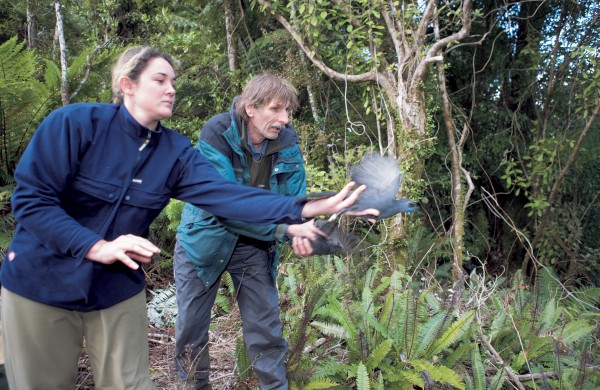
After Mapara I (Marsh) worked in numerous other kokako forests. One job was in Northland in 1995, and entailed catching and transferring single kokako from Mataraua Forest to Trounson Kauri Forest, which has since become a pest-controlled mainland island. This was the first mainland-to-mainland transfer of kokako. We obtained a good deal of our hardware—mist-netting paraphernalia, tree-climbing gear and foliage-clearing equipment—from DOC Rotorua threatened-species officer Paul Jansen. He was a former Wildlife Service man and had “done time splitting bureaucratic rocks” as chairman of the KRG.
Paul had been involved in an earlier kokako transfer. Between October 1981 and April 1983, working with wildlife officer Dick Veitch and various others, he helped catch 24 kokako in Bay of Plenty forests that were being logged and transferred them to Little Barrier Island. This was the first island posting for kokako, and the rescued birds firmly established themselves in their new home. Other transferees followed later, including, in 1994, the last two birds from nearby Great Barrier/Aotea Island. Paul has also done the country a great service in compiling over the years a DOC audio archive of the multitudinous dialects of the various kokako populations, all the more valuable since a number of his original subjects have succumbed to that terminal condition, regional extinction.
With Paul’s mist-netting gear we linked up with DOC Officers Nigel Miller and Tommy Herbert in the cloud forest of Mataraua. Mataraua abuts the better-known Waipoua Forest and is a verdant jungle of makamaka, maire, moss, mist and mud. We began by tracking a few kokako, noting the routes they took through the trees; then we selected the first of our mist-net sites, cleared it of foliage and prepared to set up the rig.
In the course of erecting a kokako mist-net rig, the top of which has to be at least as high as the surrounding forest canopy, a lot of tree-climbing must be done. Nigel was our principal climber. Wiry and light on his feet, he scaled any tree necessary—to any height necessary—to cut branches, trim back leafage and ensure our hauling tackle was free of obstructions. Often this would entail 15–20 m rope-less ascents and descents and Tarzan like traverses through interlocking canopy trees. One slip and it would have been all over. Fortunately, at that time Nigel was without question the best tree-climber in the New Zealand wildlife business.
The following day, the site slashed vegetation and a network of taut ropes and nylon strings, pulleys, scores of clips, and three linked mist nets sagging in the humidity—was finally ready. We sat down for a late lunch, reflecting upon our physical exertions and sheltering as best we could from a light drizzle. Both Nigel and Tom sucked on cigarettes while we wolfed down cheese and crackers and cold McDonalds’ burgers.
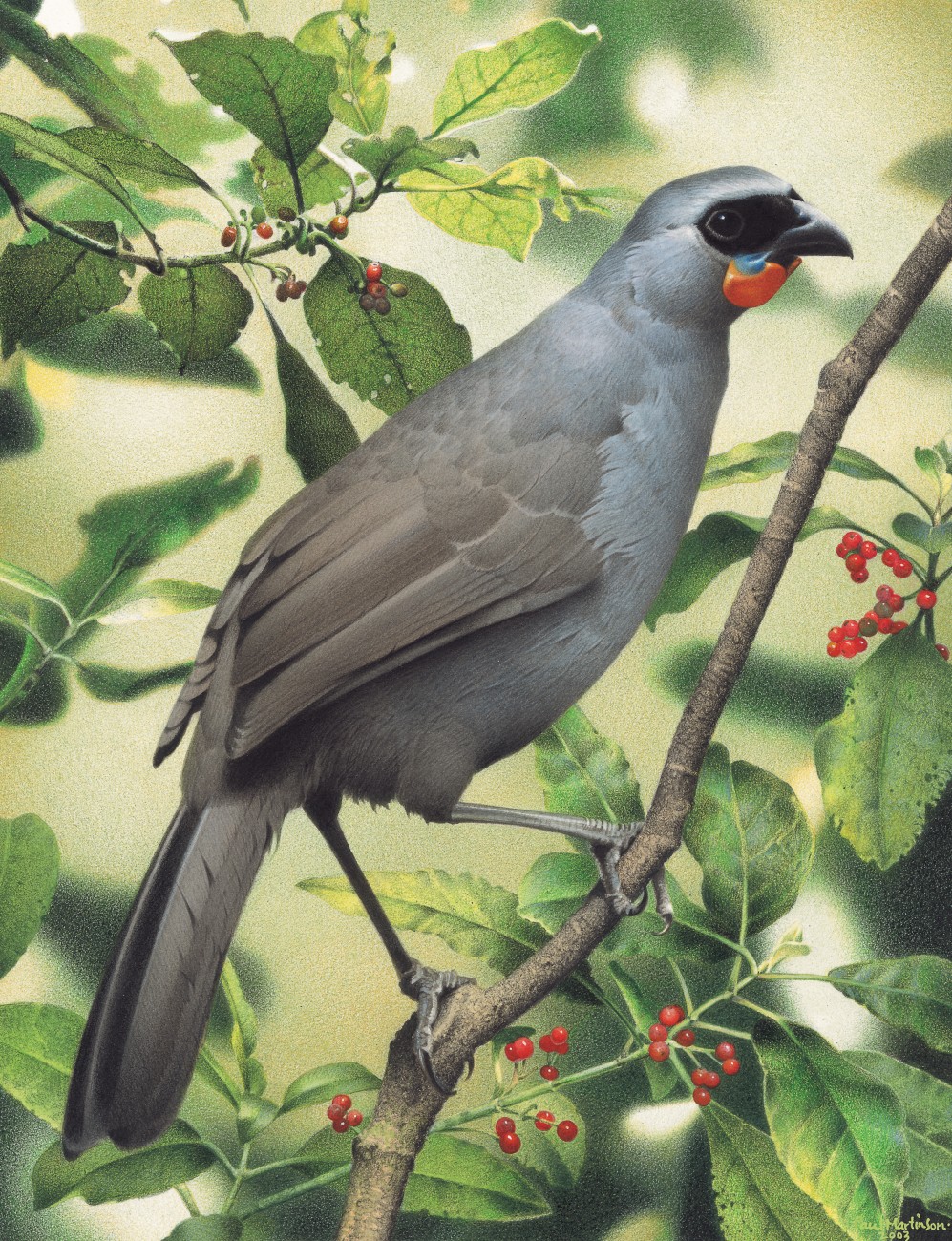
Some days later, this rig, the first of eight we put up in Mataraua Forest, netted our first kokako. The bird was lured into the near-invisible monofilament by a hidden loudspeaker—one of two hung either side of the rig—playing canned kokako song.
Catching attempts are normally undertaken from sunrise on. Ideally one waits for the kokako’s dawn chorus. Often, the initial response of the individual targeted bird, after the recorder operator has played a snatch of song, is silence. The bird will stop singing, as if in astonishment at the presence of a vocal interloper in the heart of its territory. From then on things can happen quickly. In the semi-darkness, frantic avian movements can be heard in the canopy above—a kokako looking for what it thinks is another of its kind. When it is close to the net clearing, the operator activates the speaker on the far side of the rig and plays a snatch of kokako contact calls. If all goes to plan, the catch-team, looking upwards into the half-light, can see the silhouetted kokako racing up to the edge of the clearing before launching itself straight into the net. They then drop the net and extract the bird. Occasionally a snagged kokako will emit a screech no less impressive than that of a riled kaka or kakapo.
As a species—especially since the arrival of man on New Zealand’s archipelagic shores—the North Island kokako has had much to screech about. Fortunately—also thanks to man—its “inevitable” glide to extinction has been halted. Many gifted and hardworking professionals have donated a good part of their lives to the cause—in particular, trappers, hunters and contract wildlife officers. Such field-working “gypsies” are a strange breed, not motivated by earning big money or accruing material possessions. Rather, the work they choose to do is a lifestyle job, a challenging physical adventure that they share with like-minded team-mates and that contributes towards a discernible conservation gain, be it the preservation of a stand of 800-year-old totara trees in the face of a possum onslaught, or the return of a breeding population of tieke to a mainland forest that last saw the saddleback perched in its branches sometime in the 1870s.
There are now well-established kokako populations on several offshore islands, including Little Barrier, Tiritiri-Matangi, Lady Alice and Kapiti, and plans are afoot to return the species to yet others, such as Secretary and Resolution Islands in Fiordland. On the North Island mainland kokako have been re-established in bush blocks where they flourished in the past—for example, at Boundary Stream Mainland Island in Hawke’s Bay and Pukaha Mount Bruce Wild life Centre in Wairarapa—safeguarded by regimens that closely follow the original kokako RbM formula.

Many more mainland islands are earmarked for kokako introductions—the birds to be sourced from captive institutions and those forest areas, such as Mapara, that are now thriving enclaves for the species—including, to name but a few, those at Maungatautari near Cambridge, at Whitecliffs and Lake Rotokare in Taranaki, at Wanganui’s Bushy Park, on Mokoia Island in Lake Rotorua, and at Te Moehau on the tip of Coromandel Peninsula. The most valuable ecological and spiritual taonga, however, are those protected kokako that have endured in forests such as Pureora, Hunua, Manawahe (north-west of Kawerau), Te Urewera, Mapara and Kaharoa. The KRG has set a management goal of 1000 breeding pairs nationwide by 2020 (by 2005 there were 615 pairs). From then on the issue will be whether these efforts are ecologically, politically and financially sustainable.
The Kaharoa Kokako Trust’s 2006 pre-breeding census found a substantial increase in numbers, with birds spilling over into bush tracts adjacent to the pest-controlled area. All up, there are now no fewer than 60 confirmed breeding pairs and 17 single birds, making 137 territory-holding kokako, as well as a large number of transient juveniles. When the trust began its operation 10 years ago there were a mere 12 pairs struggling to survive in the forest. Kaharoa now also has healthy populations of other bush birds, including some of New Zealand’s rarer endemics, such as whio, toutouwai (North Island robin), matata (fernbird), karearea (New Zealand falcon) and kaka, plus a handful of kiwi, all of which benefit from the trust’s pest-control programme.
Thanks are due to the handful of people, such as Carmel Richardson and her associates, who, assisted by staff from DOC Rotorua, continue to collate data, clear stoat traps, shoot goats and track kokako through the forest, ensuring that this splendid bird continues to prosper.

















